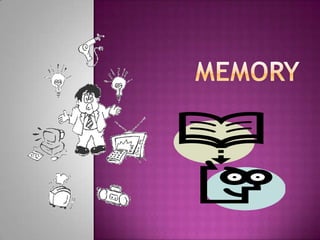
Memory and Thinking
- 2. The retention of information over time through encoding, storage, and retrieval. ENCODING GETTING INFORMATION into MEMORY STORAGE Retaining information over time RETRIEVAL Taking information out of storage
- 3. Encoding- is the process in which information gets into memory storage.
- 4. Selective Attention Divided Attention
- 5. Levels of Processing Theory States that memory is on a continuum from shallow to deep, with deeper processing producing better memory. Shallow Level- the sensory or physical features of stimuli are analyzed. Intermediate Level- the stimulus is recognized and given a label. Deepest Level- we make associations.
- 6. It is the extensiveness of processing at any given level of memory.
- 7. Memory is encoded through IMAGES. DUAL CODE HYPOTHESIS (Allan Paivio)- states that memory for images is better than memory for words because the memory for images is stored as an image code and as a verbal code.
- 8. SENSORY MEMORY Attention Short- Term Memory Rehearsal Long- Term Memory Retrieval Storage encompasses how information is retained over time and how it is represented in memory. Atkinson-Shiffrin Theory - the view that memory involves a sequence of three stages:
- 9. Holds information from the world in its original form only for an instant, not much longer than the brief time it is exposed to the visual, auditory and other senses. Echoic Memory- auditory senses Iconic Memory- visual senses
- 10. Is a limited capacity memory system in which information is retained for only as long as 30 seconds unless strategies are used to retained it longer.
- 11. Chunking- involves grouping or packing information. A form of memory encoding: specifically, elaboration. It works by making large amounts of information more manageable. Rehearsals- the conscious repetition of information. Information stored in short- term memory lasts half a minute or less without rehearsal.
- 12. A three- part system that temporarily holds information. It is a kind of mental workbench on which information is manipulated and assembled to perform other cognitive tasks. Three components of working memory: Phonological Loop Visuospatial Working Memory Central Executive
- 13. Visuospatial Working Memory CENTRAL EXCUTIVE Phonological Loop Input via Sensory Memory Long- Term Memory
- 14. A relatively permanent type of memory that holds huge amounts of information for a long period of time. It is divided into substructures: Explicit Memory Implicit Memory
- 15. Also called as DECLARATIVE MEMORY. The conscious recollection of information, such as specific facts, or events, and at least in humans, information that can be verbally communicated. Episodic Memory- the retention of information about the where and when of life’s happenings. Semantic Memory- a person’s knowledge about the world.
- 16. Retrospective Memory- remembering the past. Prospective- remembering information about doing something in the future; includes memory for intentions. Time- based prospective memory- intention to engage in a given behavior after a specified amount of time has gone by. Event- based prospective memory- you engage in the intended behavior when it is elicited by some external event or cue.
- 17. Also called as NONDECLARATIVE MEMORY. Memory in which behavior is affected by prior experience without that experience being consciously recollected. Procedural Memory- involves memory for skills. Priming- is the activation of information that people already have in storage to help them remember new information better and faster. Classical Conditioning- involves the automatic learning of associations between stimuli.
- 20. It is using the knowledge that has been gathered and processed; mentally manipulating concepts and images to perform such mental activities as reasoning, solving problems, producing and understanding language and making decisions. Cognition- the process of gathering and processing information, including sensing, perceiving, learning, remembering and thinking.
- 21. The type of thinking needed when there is only one correct answer or solution to a problem. We select or converge on, a single correct answer or solution from among several alternatives.
- 22. It is the opposite of convergent thinking. We generate as many different, or divergent solutions as possible. It is the type of thinking most often associated with creativity.
- 23. Brain Storming Free Writing Journal Mind Mapping
- 24. Papalia, D. et al (2004). Human Development 9th edition. Mcgraw Hill Kalat James W. (2002). Introduction to Psychology 6th Edition
